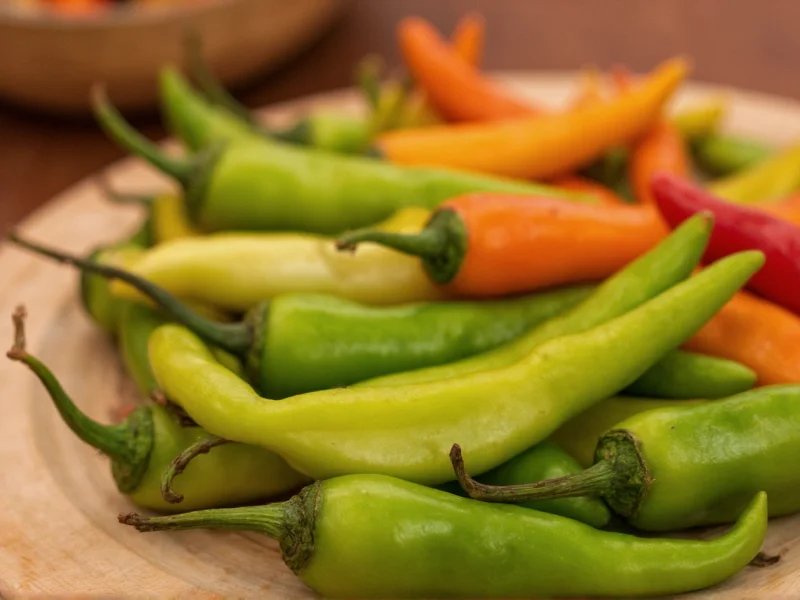When exploring the world of chili peppers, many home cooks and spice-sensitive individuals seek varieties that deliver flavor without the burn. Understanding the mildest chili peppers opens up culinary possibilities for those who want to enjoy pepper characteristics without overwhelming heat. This guide examines the complete spectrum of mild chili options, their flavor profiles, and practical applications in everyday cooking.
Understanding Pepper Heat Measurement
The Scoville scale measures chili pepper heat by determining capsaicin concentration—the compound responsible for spiciness. Developed by Wilbur Scoville in 1912, this scale assigns values in Scoville Heat Units (SHU), with higher numbers indicating greater heat intensity. Pure capsaicin registers at 16 million SHU, while water sits at 0 SHU. Most mild peppers fall below 5,000 SHU, creating a comfortable range for spice-averse individuals.
Top Mild Chili Pepper Varieties
While bell peppers technically belong to the same Capsicum annuum species as many hot peppers, their genetic mutation prevents capsaicin production, resulting in zero heat. Beyond bell peppers, several genuinely mild chili varieties offer nuanced flavors worth exploring:
Sweet Banana Peppers
These vibrant yellow to red peppers measure 0-500 SHU, making them exceptionally mild. Their sweet, slightly tangy flavor works well in salads, sandwiches, and pickled preparations. Gardeners appreciate their high yield and adaptability to various growing conditions. When selecting banana peppers, choose firm specimens with smooth skin for optimal freshness.
Cubanelle Peppers
Also known as Italian frying peppers, Cubanelles register between 100-1,000 SHU. Their thin walls and sweet, slightly floral notes make them perfect for sautéing, stuffing, or adding to egg dishes. Unlike many mild peppers, Cubanelles maintain their delicate flavor when cooked, rather than becoming bitter. They're frequently used in Italian and Puerto Rican cuisines for this reason.
Anaheim Peppers
Measuring 500-2,500 SHU, Anaheim peppers offer a gentle warmth with earthy, almost fruity undertones. Originally cultivated in New Mexico but popularized in California, these long, slender peppers work well roasted, stuffed, or incorporated into sauces. Their moderate heat level makes them an excellent transition pepper for those expanding their spice tolerance.
Poblano Peppers
At 1,000-2,000 SHU, poblanos provide subtle warmth with rich, almost chocolatey notes. When dried, they become ancho peppers, a staple in Mexican mole sauces. Their thick walls hold up well to roasting and stuffing, making them ideal for dishes like chiles rellenos. Interestingly, poblanos occasionally produce unexpectedly hot specimens—a phenomenon known as "chile variability."
| Pepper Variety | Scoville Range (SHU) | Flavor Profile | Best Culinary Uses |
|---|---|---|---|
| Bell Peppers | 0 | Sweet, grassy, crisp | Raw in salads, stir-fries, stuffed dishes |
| Sweet Banana | 0-500 | Tangy-sweet, mild | Pickling, sandwiches, salads |
| Cubanelle | 100-1,000 | Floral, sweet, delicate | Sautéing, frying, stuffing |
| Anaheim | 500-2,500 | Earthy, slightly fruity | Roasting, sauces, stuffed dishes |
| Poblano | 1,000-2,000 | Rich, chocolatey, mild heat | Mole sauces, chiles rellenos, roasting |
Practical Applications in Cooking
Using mild chili peppers effectively requires understanding their unique properties. Sweet banana peppers maintain their crisp texture when raw but become exceptionally tender when cooked. For optimal flavor extraction, roast Cubanelle peppers until their skins blister, then peel before incorporating into dishes. Anaheim peppers benefit from removing seeds and membranes—even in mild varieties, these parts contain higher capsaicin concentrations.
When substituting mild peppers in recipes calling for hotter varieties, consider adding complementary flavors to maintain complexity. A touch of smoked paprika can replicate the depth of chipotle peppers when using poblanos, while a splash of vinegar enhances the brightness of banana peppers in place of jalapeños.
Common Misconceptions About Mild Peppers
Many assume all green peppers are mild, but color indicates ripeness rather than heat level—some green varieties like habaneros are extremely hot. Similarly, size doesn't correlate with spiciness; small peperoncini can be milder than large bell peppers. The mildest chili peppers for beginners often surprise experienced cooks with their complex flavor profiles beyond simple sweetness.
Selecting and Storing Mild Peppers
Choose firm peppers with taut, glossy skin and avoid those with wrinkles or soft spots. Store unwashed peppers in the crisper drawer of your refrigerator for up to two weeks. For longer preservation, roast and freeze poblano or Anaheim peppers, or pickle banana and Cubanelle varieties. Remember that mild peppers lose flavor more quickly than hotter varieties when frozen, so use preserved mild peppers within six months for best results.
Expanding Your Mild Pepper Experience
As your palate develops, experiment with slightly hotter varieties like Hungarian wax peppers (1,000-15,000 SHU) in their yellow stage, which often test at the lower end of their range. Growing your own mild peppers ensures freshness and lets you control growing conditions that affect heat levels. Many gardeners discover that consistent watering and adequate soil nutrients produce milder fruits, while stressors like drought can increase capsaicin production even in typically mild varieties.











 浙公网安备
33010002000092号
浙公网安备
33010002000092号 浙B2-20120091-4
浙B2-20120091-4